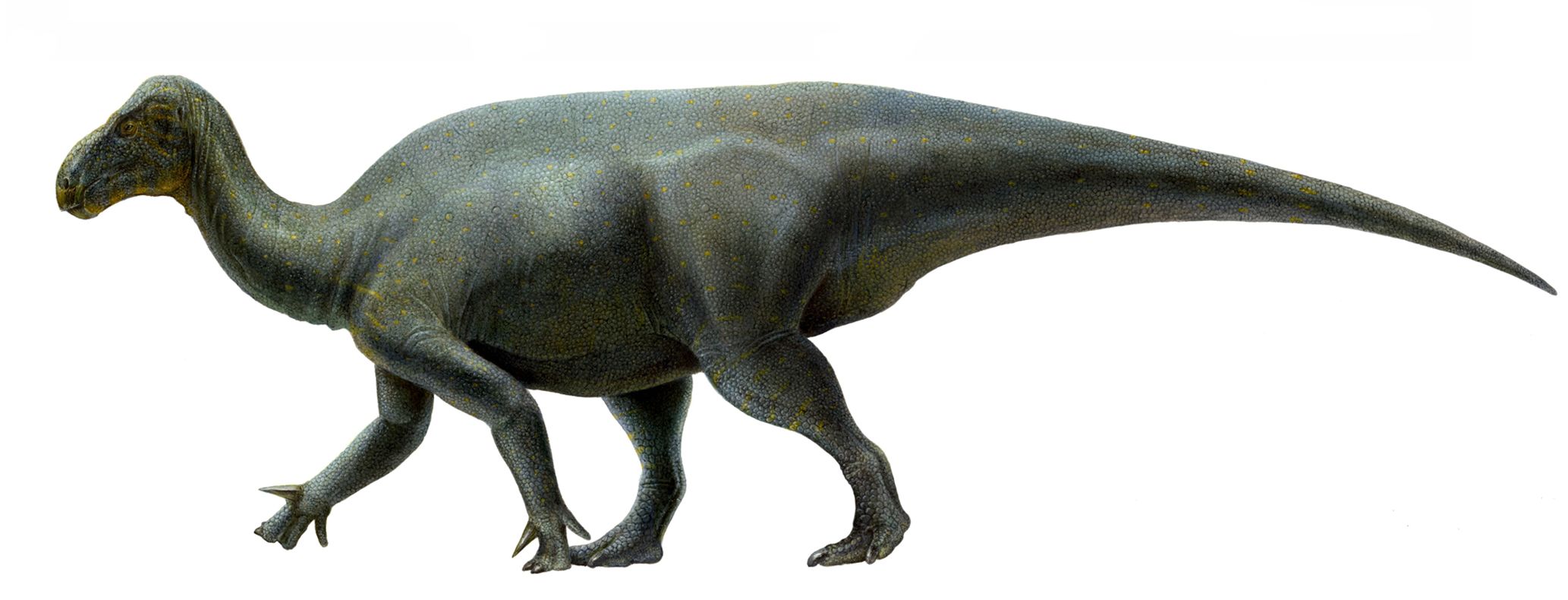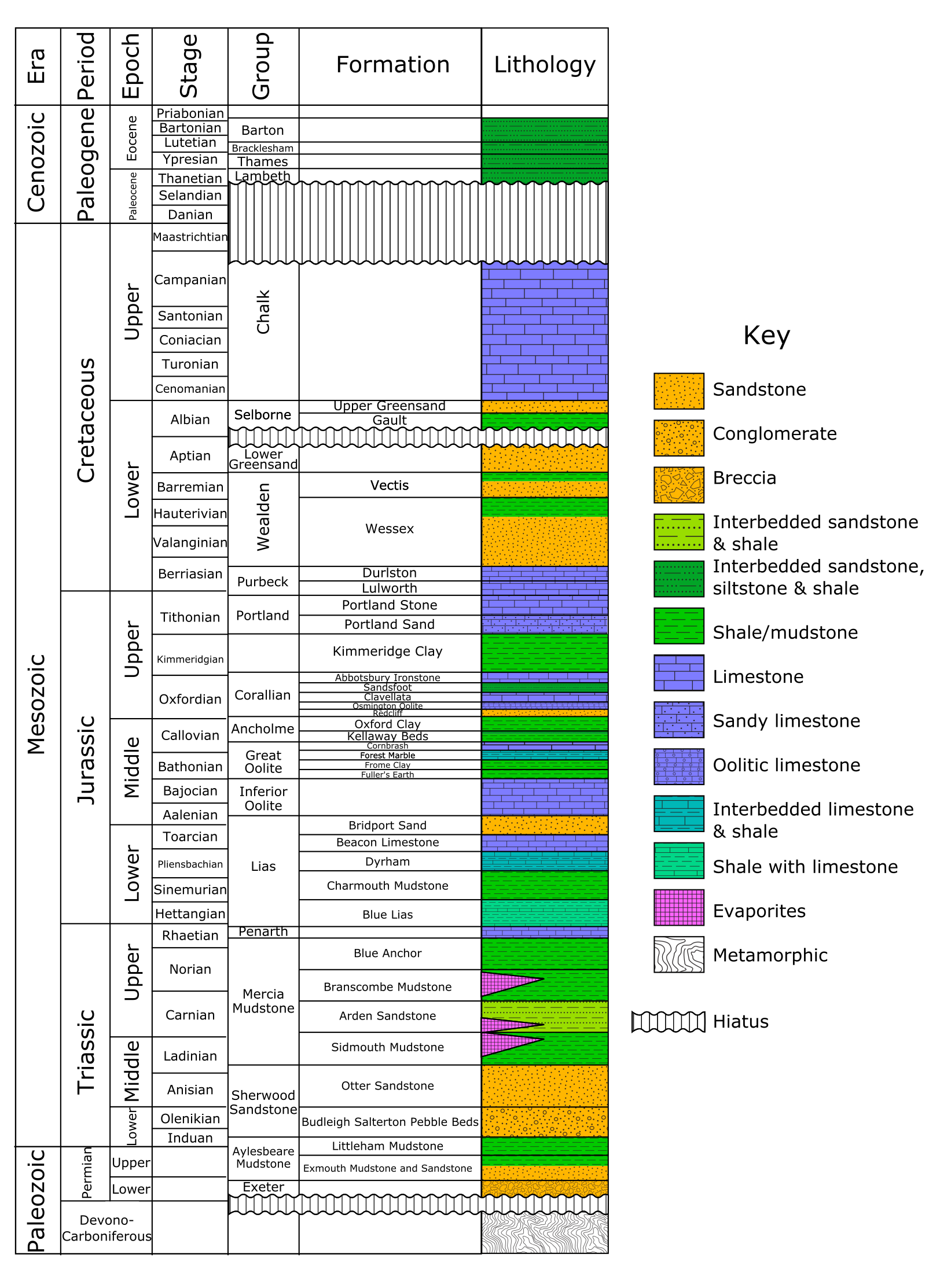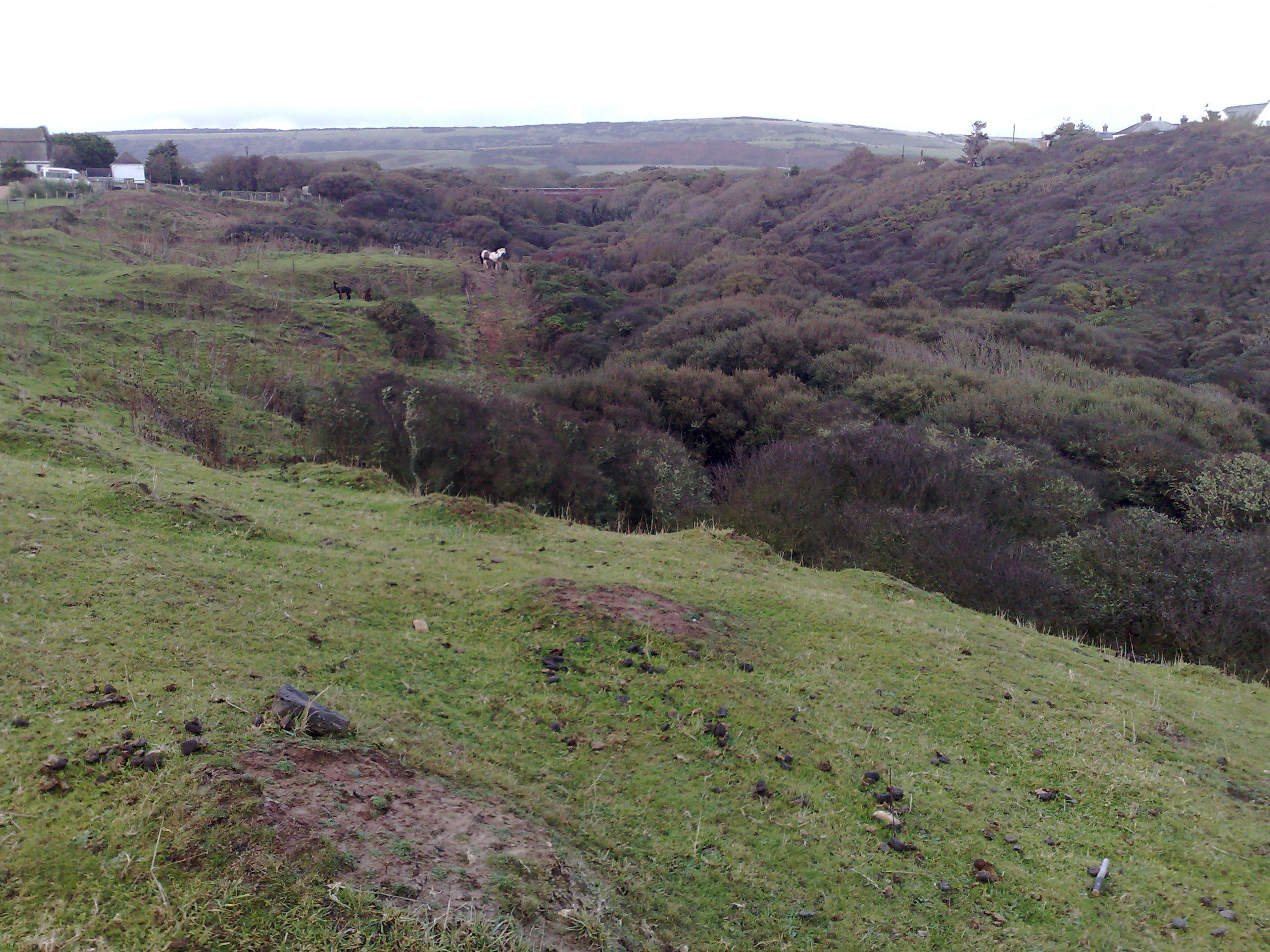|
Brighstoneus
''Brighstoneus'' (after Brighstone, a village on the Isle of Wight) is a genus of hadrosauriform dinosaur from the Early Cretaceous Wessex Formation of the Isle of Wight, England. The genus contains a single species, ''Brighstoneus simmondsi'', known from a partial skeleton. History of discovery The holotype specimen, MIWG 6344, was discovered along with the holotype of ''Neovenator'' during the summer of 1978, when a storm made part of the Grange Chine collapse. Rocks containing fossils fell to the beach of Brighstone Bay on the southwestern coast of the Isle of Wight. The rocks were part of plant debris bed L9 within the variegated clays and marls of the Wessex Formation dating from the Barremian stage of the Early Cretaceous, about 125 million years ago. They were first collected by the Henwood family and shortly afterwards by geology student David Richards. Richards sent the remains to the Museum of Isle of Wight Geology and the British Museum of Natural History. In the ... [...More Info...] [...Related Items...] OR: [Wikipedia] [Google] [Baidu] |
Brighstone
Brighstone is a village and civil parish on the Isle of Wight, 6 miles southwest of Newport on the B3399 road. Brighstone was previously known as "Brixton". The name derives from the Saxon name " Ecgbert's Tun". Brighstone is the largest village in the area locally known as the Back of the Wight and extends toward Limerstone and Mottistone. In Roman times a villa was built to the north, to take advantage of the clean waters of the Buddle Brook. History Brighstone history dates back to the 9th century when it was given to the Bishopric of Winchester by King Egbert. Brighstone parish was formed in 1644. The civil parish comprises the main village of Brighstone together with the smaller villages of Brook, Hulverstone, Limerstone and Mottistone. The entire parish lies within an area of the Isle of Wight AONB and its coastline is designated as Heritage Coast and Site of Special Scientific Interest. St. Mary's Church, Brighstone is a venerable old church that has stood for ... [...More Info...] [...Related Items...] OR: [Wikipedia] [Google] [Baidu] |
Neovenator
''Neovenator'' (nee-o-ven-a-tor meaning "new hunter") is a genus of carcharodontosaurian theropod dinosaur. It is known from several skeletons found in the Early Cretaceous (Barremian~130-125 million years ago) Wessex Formation on the south coast of the Isle of Wight, southern England. It is one of the best known theropod dinosaurs from the Early Cretaceous of Europe. Discovery and species The first bones of ''Neovenator'' were discovered in the summer of 1978, when a storm made part of the Grange Chine collapse. Rocks containing fossils fell to the beach of Brighstone Bay on the southwestern coast of the Isle of Wight. The rocks consisted of plant debris bed L9 within the variegated clays and marls of the Wessex Formation dating from the Barremian stage of the Early Cretaceous, about 125 million years ago. They were first collected by the Henwood family and shortly afterwards by geology student David Richards. Richards sent the remains to the Museum of Isle of Wight (no ... [...More Info...] [...Related Items...] OR: [Wikipedia] [Google] [Baidu] |
Hadrosauriformes
Ankylopollexia is an extinct clade of ornithischian dinosaurs that lived from the Late Jurassic to the Late Cretaceous. It is a derived clade of iguanodontian ornithopods and contains the subgroup Styracosterna. The name stems from the Greek word, “ankylos”, mistakenly taken to mean stiff, fused (in fact the adjective means bent or curved; used of fingers, it can mean hooked), and the Latin word, “pollex”, meaning thumb. Originally described in 1986 by Sereno, a most likely synapomorphic feature of a conical thumb spine defines the clade.Sereno, P.C. (1986). "Phylogeny of the bird-hipped dinosaurs (order Ornithischia)". National Geographic Research 2 (2): 234–56 First appearing around 156 million years ago, in the Jurassic, Ankylopollexia became an extremely successful and widespread clade during the Cretaceous, and were found around the world. The group died out at the end of the Maastrichtian. They grew to be quite large, comparable to some carnivorous dinosaurs and t ... [...More Info...] [...Related Items...] OR: [Wikipedia] [Google] [Baidu] |
2021 In Archosaur Paleontology
This article records new taxa of fossil archosaurs of every kind that are scheduled binomial nomenclature, described during the year 2021, as well as other significant discoveries and events related to paleontology of archosaurs that are scheduled to occur in the year 2021. General research * A study on the relationship between full potential joint mobility and the poses used during locomotion in extant American alligator and helmeted guineafowl, evaluating its implications for reconstructions of locomotion of extinct archosaurs, is published by Manafzadeh, Kambic & Gatesy (2021). * A study on the Femur, femoral shape variation and on the relationship between femoral morphology and locomotor habits in early archosaurs and non-archosaur Archosauriformes, archosauriforms is published by Pintore ''et al.'' (2021). * A study estimating moment arms for major Pelvis, pelvic limb muscles in extant and fossil archosaurs, aiming to investigate the idea that bird-line archosaurs switched fr ... [...More Info...] [...Related Items...] OR: [Wikipedia] [Google] [Baidu] |
Ankylopollexia
Ankylopollexia is an extinct clade of ornithischian dinosaurs that lived from the Late Jurassic to the Late Cretaceous. It is a derived clade of iguanodontian ornithopods and contains the subgroup Styracosterna. The name stems from the Greek word, “ankylos”, mistakenly taken to mean stiff, fused (in fact the adjective means bent or curved; used of fingers, it can mean hooked), and the Latin word, “pollex”, meaning thumb. Originally described in 1986 by Sereno, a most likely synapomorphic feature of a conical thumb spine defines the clade.Sereno, P.C. (1986). "Phylogeny of the bird-hipped dinosaurs (order Ornithischia)". National Geographic Research 2 (2): 234–56 First appearing around 156 million years ago, in the Jurassic, Ankylopollexia became an extremely successful and widespread clade during the Cretaceous, and were found around the world. The group died out at the end of the Maastrichtian. They grew to be quite large, comparable to some carnivorous dinosaurs and ... [...More Info...] [...Related Items...] OR: [Wikipedia] [Google] [Baidu] |
Wessex Formation
The Wessex Formation is a fossil-rich English geological formation that dates from the Berriasian to Barremian stages (about 145–125 million years ago) of the Early Cretaceous. It forms part of the Wealden Group and underlies the younger Vectis Formation and overlies the Durlston Formation. The dominant lithology of this unit is mudstone with some interbedded sandstones. It is part of the strata of the Wessex Basin, exposed in both the Isle of Purbeck and the Isle of Wight. While the Purbeck sections are largely barren of vertebrate remains, the Isle of Wight sections are well known for producing the richest and most diverse fauna in Early Cretaceous Europe. Nomenclatural History The Wessex Formation has historically alternately been called the "Variegated Marls And Sandstones", a name used by W. J. Arkell in his 1947 map of the Isle of Purbeck as well as the "Wealden Marls" It was given its current formal name by Daley and Stewart in 1979 Stratigraphy and Lithology In ... [...More Info...] [...Related Items...] OR: [Wikipedia] [Google] [Baidu] |
Grange Chine
Grange Chine and Marsh Chine form a geological feature on the south west coast of the Isle of Wight, England. They lie to the south of the village of Brighstone. These two chines form the largest chine feature on the Isle of Wight. The Grange Chine starts at the southern edge of Brighstone and runs south-west, crosses under the A3055 Military Road at the hamlet of Marsh Green then continues for about five hundred metres to reach the beach at Brighstone Bay. The Marsh Chine starts to the east of Marsh Green alongside the A3055 and runs west where it joins the larger Grange Chine before it reaches the beach. Both chines have much shallower sides than other chines on the Isle of Wight and are extensively covered with hardy bushes, stunted trees and scrub. The Chines drain water from the southern slopes of Brighstone Down and from as far as Shorwell to the east. The stream ( the Buddle Brook) formed is significant enough to power two mills, Yafford Mill and Brighstone Mill ... [...More Info...] [...Related Items...] OR: [Wikipedia] [Google] [Baidu] |
Early Cretaceous
The Early Cretaceous ( geochronological name) or the Lower Cretaceous (chronostratigraphic name), is the earlier or lower of the two major divisions of the Cretaceous. It is usually considered to stretch from 145 Ma to 100.5 Ma. Geology Proposals for the exact age of the Barremian-Aptian boundary ranged from 126 to 117 Ma until recently (as of 2019), but based on drillholes in Svalbard the defining early Aptian Oceanic Anoxic Event 1a (OAE1a) was carbon isotope dated to 123.1±0.3 Ma, limiting the possible range for the boundary to c. 122–121 Ma. There is a possible link between this anoxic event and a series of Early Cretaceous large igneous provinces (LIP). The Ontong Java-Manihiki-Hikurangi large igneous province, emplaced in the South Pacific at c. 120 Ma, is by far the largest LIP in Earth's history. The Ontong Java Plateau today covers an area of 1,860,000 km2. In the Indian Ocean another LIP began to form at c. 120 Ma, the Kerguelen P ... [...More Info...] [...Related Items...] OR: [Wikipedia] [Google] [Baidu] |
Specific Name (zoology)
In zoological nomenclature, the specific name (also specific epithet or species epithet) is the second part (the second name) within the scientific name of a species (a binomen). The first part of the name of a species is the name of the genus or the generic name. The rules and regulations governing the giving of a new species name are explained in the article species description. For example, the scientific name for humans is ''Homo sapiens'', which is the species name, consisting of two names: ''Homo'' is the " generic name" (the name of the genus) and ''sapiens'' is the "specific name". Historically, ''specific name'' referred to the combination of what are now called the generic and specific names. Carl Linnaeus, who formalized binomial nomenclature, made explicit distinctions between specific, generic, and trivial names. The generic name was that of the genus, the first in the binomial, the trivial name was the second name in the binomial, and the specific the proper term for ... [...More Info...] [...Related Items...] OR: [Wikipedia] [Google] [Baidu] |
Autapomorphies
In phylogenetics, an autapomorphy is a distinctive feature, known as a derived trait, that is unique to a given taxon. That is, it is found only in one taxon, but not found in any others or outgroup taxa, not even those most closely related to the focal taxon (which may be a species, family or in general any clade). It can therefore be considered an apomorphy in relation to a single taxon. The word ''autapomorphy'', first introduced in 1950 by German entomologist Willi Hennig, is derived from the Greek words αὐτός, ''autos'' "self"; ἀπό, ''apo'' "away from"; and μορφή, ''morphḗ'' = "shape". Discussion Because autapomorphies are only present in a single taxon, they do not convey information about relationship. Therefore, autapomorphies are not useful to infer phylogenetic relationships. However, autapomorphy, like synapomorphy and plesiomorphy is a relative concept depending on the taxon in question. An autapomorphy at a given level may well be a synapomorphy at ... [...More Info...] [...Related Items...] OR: [Wikipedia] [Google] [Baidu] |
Iguanodontia
Iguanodontia (the iguanodonts) is a clade of herbivorous dinosaurs that lived from the Middle Jurassic to Late Cretaceous. Some members include ''Camptosaurus'', ''Dryosaurus'', ''Iguanodon'', ''Tenontosaurus'', and the hadrosaurids or "duck-billed dinosaurs". Iguanodontians were one of the first groups of dinosaurs to be found. They are among the best known of the dinosaurs, and were among the most diverse and widespread herbivorous dinosaur groups of the Cretaceous period. Classification Iguanodontia is often listed as an infraorder within a suborder Ornithopoda, though Benton (2004) lists Ornithopoda as an infraorder and does not rank Iguanodontia. Traditionally, iguanodontians were grouped into the superfamily Iguanodontoidea and family Iguanodontidae. However, phylogenetic studies show that the traditional "iguanodontids" are a paraphyletic grade leading up to the hadrosaurs (duck-billed dinosaurs). Groups like Iguanodontoidea are sometimes still used as unranked clades ... [...More Info...] [...Related Items...] OR: [Wikipedia] [Google] [Baidu] |
Neural Spine
The spinal column, a defining synapomorphy shared by nearly all vertebrates,Hagfish are believed to have secondarily lost their spinal column is a moderately flexible series of vertebrae (singular vertebra), each constituting a characteristic irregular bone whose complex structure is composed primarily of bone, and secondarily of hyaline cartilage. They show variation in the proportion contributed by these two tissue types; such variations correlate on one hand with the cerebral/caudal rank (i.e., location within the backbone), and on the other with phylogenetic differences among the vertebrate taxa. The basic configuration of a vertebra varies, but the bone is its ''body'', with the central part of the body constituting the ''centrum''. The upper (closer to) and lower (further from), respectively, the cranium and its central nervous system surfaces of the vertebra body support attachment to the intervertebral discs. The posterior part of a vertebra forms a vertebral arch (in ... [...More Info...] [...Related Items...] OR: [Wikipedia] [Google] [Baidu] |
%2C_IW%2C_UK.jpg)






